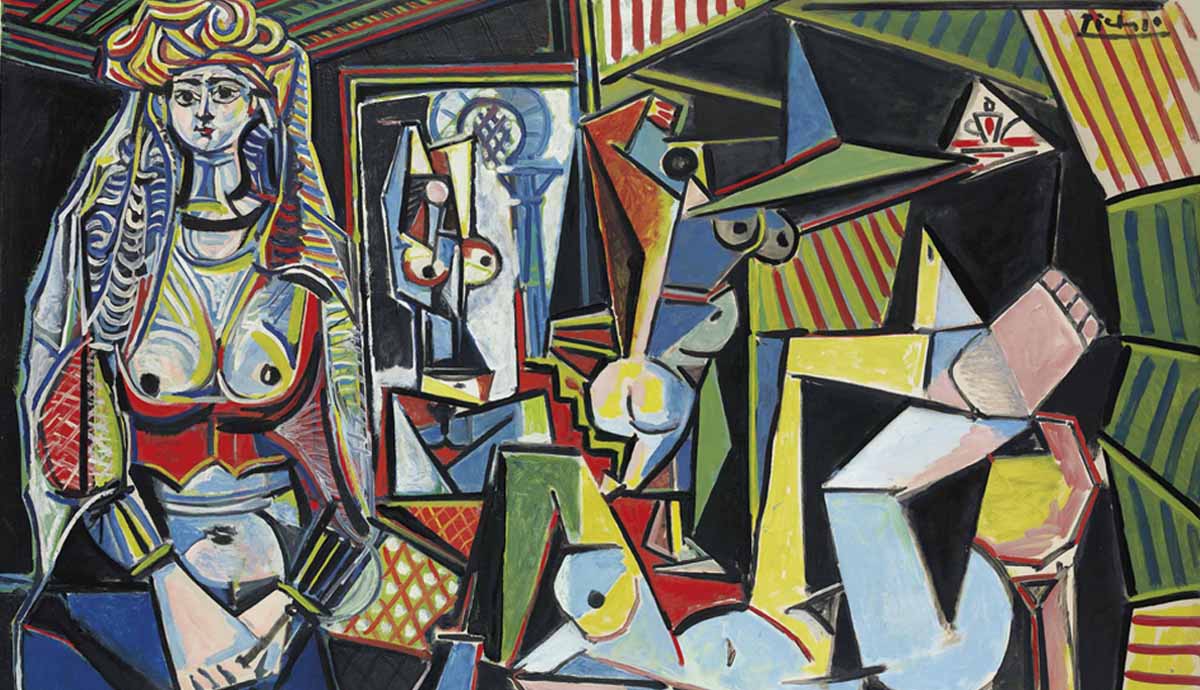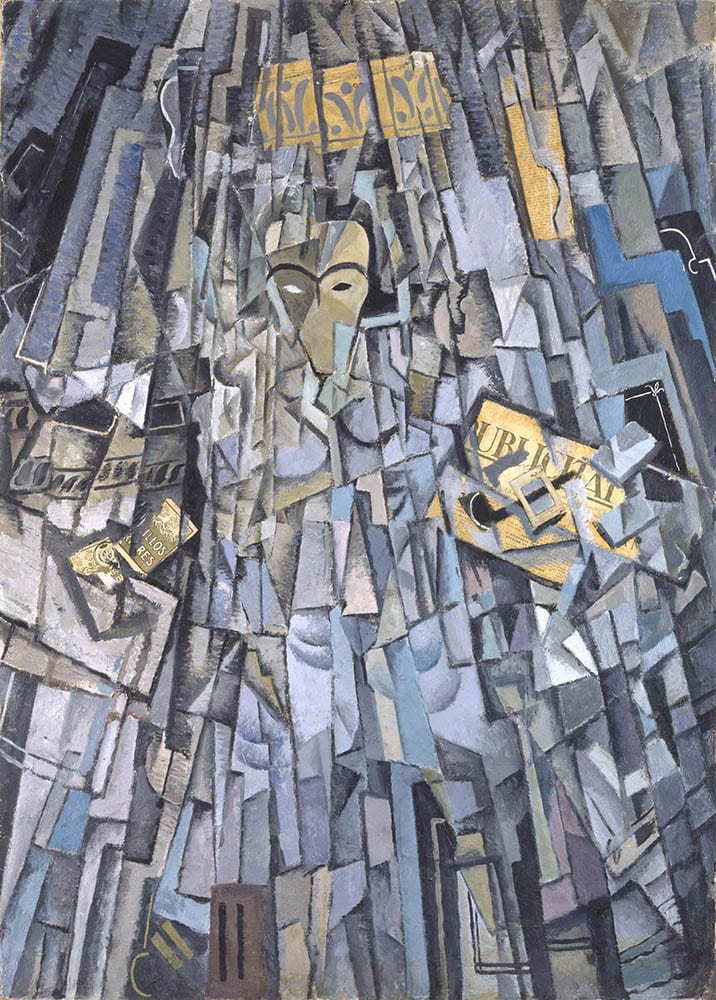Late 20th Century Cubism Style of Art of Human Figure

Cubism art was a mod movement that is known today every bit the most influential menstruum in 20th-century art . Information technology has also inspired subsequent styles in architecture and literature. It is known for its deconstructed, geometric representations and breakdowns of spatial relativity. Adult by Pablo Picasso and Georges Braque amid others, Cubism drew on post-impressionist art, and specially the works of Paul Cézanne, which challenged traditional notions of perspective and grade. Below are x iconic cubist works and the artists who produced them.
Proto Cubism Art
Proto-Cubism is the introductory phase of Cubism that began in 1906. This period reflects the experimentation and influences that resulted in geometric shapes and a more than muted color palette in sharp contrast to the preceding Fauvist and postal service-impressionis t movements.
Les Demoiselles d'Avignon (1907) by Pablo Picasso

Pablo Picasso was a Spanish painter, printmaker, sculptor, and ceramicist who is known as ane of the most prolific influences on 20th-century fine art. He, along with Georges Braque, founded the Cubism movement in the early on 1900s. Withal, he also made significant contributions to other movements including Expressionism and Surrealism . His work was known for its angular shapes and challenging traditional perspectives.
Les Demoiselles d'Avignon depicts 5 nude women in a brothel in Barcelona. The piece is rendered in muted, paneled block colors. All the figures stand to face the viewer, with slightly disconcerting facial expressions. Their bodies are angular and disjointed, standing every bit if they are posing for the viewer. Below them sits a pile of fruit posed for a still life. The slice is one of the most famous examples of Cubism's deviation from traditional aesthetics.
Houses at L'Estaque (1908) by Georges Braque

Are you enjoying this commodity?
Sign up to our Free Weekly Newsletter
Please bank check your inbox to activate your subscription
Cheers!
Georges Braque was a French painter, printmaker, draughtsman and sculptor who was a leading creative person in both the Fauvism and Cubism movements. He was closely associated with Pablo Picasso during early Cubism and remained loyal to the move throughout the rest of his career despite changing his style and color utilise. His about famous work is characterized by bold coloration and sharp, defined angles.
Houses at 50'Estaque reflects the transition from mail service-impressionism into Proto-Cubism. The viewer can see the influence of Paul Cézanne in the compatible brushstrokes and thick paint awarding. However, Braque incorporated elements of cubist brainchild by removing the horizon line and playing with perspective. The houses are fragmented, with inconsistent shadows and a background that blends in with the objects.
Belittling Cubism
Analytical Cubism in the early phase of Cubism, start in 1908 and ending effectually 1912. Information technology is characterized by the deconstructed representations of objects with contradictory shadows and planes, which play with traditional notions of perspective. It as well featured the restricted color palette of Proto-Cubism.
Violin and Candlestick (1910) by Georges Braque

Violin and Candlestick depicts an abstracted violin and candlestick withal life. Information technology is composed on a filigree with deconstructed elements that form a single composition, allowing the viewer to draw their interpretation of the piece. It is rendered in muted tones of brown, grey and black, with juxtaposing shadows and a flattened perspective. Information technology consists mainly of flat, horizontal castor strokes and sharp outlines.
I and the Village (1911) by Marc Chagall

Marc Chagall was a Russian-French painter and printmaker who used dream iconography and emotive expression in his piece of work. His work predated the imagery of Surrealism and used poetic and personal associations rather than traditional artistic representations. He worked in several different mediums throughout his career and studied under a stained-glass maker which led to him to accept up its craftsmanship.
I and the Hamlet depicts an autobiographical scene from Chagall'south childhood in Russia. It portrays a surreal, dream-like setting with folk symbols and elements from the boondocks of Vitebsk, where Chagall grew up. The piece is thus highly emotional and focuses on several associations with the artist'south significant memories. It has intersecting, geometric panels with blended colors, disruptive the perspective and disorienting the viewer.
Tea Time (1911) past Jean Metzinger

Jean Metzinger was a French artist and author who wrote the leading theoretical work on Cubism with beau artist Albert Gleizes . He worked in the Fauvist and Divisionist styles in the early 1900s, utilizing some of their elements in his cubist works including bold colors and defined outlines. He was besides influenced by Pablo Picasso and Georges Braque, who he met when he moved to Paris to pursue a career as an artist.
Tea Fourth dimension represents Metzinger's hybridization of classical art with modernism. Information technology is a portrait of a woman having tea in a characteristic cubist composition. Information technology resembles classical and Renaissance bust portraiture simply has a modern, abstracted figure and elements of spatial baloney. The adult female's body and the teacup are both deconstructed, featuring plays on light, shadow and perspective. The color scheme is muted, with elements of cherry and green blended into information technology.
Constructed Cubism
Synthetic Cubism is the later period of Cubism spanning between 1912 and 1914. While the precedent Belittling Cubism period was focused on fragmenting objects, Constructed Cubism emphasized experimentation with textures, flattened perspective and brighter colors.
Portrait of Pablo Picasso (1912) by Juan Gris

Juan Gris was a Spanish painter and a leading member of the Cubism movement. He was function of the 20th-century avant-garde, working alongside Pablo Picasso, Georges Braque and Henri Matisse in Paris. He also designed ballet sets for the art critic and founder of the 'Ballets Russes' Sergei Diaghilev. His painting was known for its rich colors, sharp forms and reformation of spatial perspective.
Portrait of Pablo Picasso represents Gris' homage to his artistic mentor, Pablo Picasso. The piece is reminiscent of Analytic Cubism works, with spatial deconstruction and paradoxical angles. However, it likewise features a more structured geometric composition, with clear color planes and pops of colour. The background angles fade into those of Picasso'south face, flattening the piece and blending the subject area with the background.
Guitar (1913) by Pablo Picasso

Guitar perfectly represents the shift between Analytical Cubism and Synthetic Cubism. The piece is a collage combined with drawn elements, fabricated upwardly of paper and newspaper clippings, calculation varying degrees of depth and texture. It portrays disjointed and asymmetric parts of a guitar, recognizable just past the key shape and circle. Its mainly biscuit, blackness and white colour scheme is contrasted by a brilliant blue background, emphasizing the bold colors of Synthetic Cubism.
The Sunblind (1914) by Juan Gris

The Sunblind portrays a closed blind partially covered by a wooden tabular array. Information technology is a charcoal and chalk composition with collage elements, calculation in textures typical of a Synthetic Cubism piece. Gris uses perspective and size distortions between the table and the bullheaded to add an element of defoliation. The bright blue color both contracts confronting and frames the key table, calculation textural variation and an asymmetrical balance.
Later Work with Cubism Art
While Cubism's innovation peaked between 1908-1914, the movement had a monumental impact on modernistic art. Information technology appeared throughout the 20th-century in European art and had a considerable bear upon on Japanese and Chinese fine art between 1910 and 1930.
Cubist Self-Portrait (1926) by Salvador Dalí

Salvador Dalí was a Castilian artist who was closely linked to Surrealism. His piece of work is some of the most notable and recognizable of the movement, and he remains i of its nigh prominent contributors. His art is known for its precision and is characterized by dreamlike imagery, Catalonian landscapes and bizarre imagery. However, despite his primary interest with Surrealism, Dalí too experimented with the Dadaism and Cubism movements during the beginning half of the 20th century.
Cubist Self-Portrait exemplifies the work washed in Dalí's cubist stage between 1922-23 and 1928. He was influenced by the works of Pablo Picasso and Georges Braque and experimented with other outside influences during the fourth dimension that he made cubist works. His cocky-portrait exemplifies these combined influences. Information technology has an African way mask at its center, surrounded by collaged elements typical of Synthetic Cubism, and featuring the muted color palette of Analytical Cubism.
Guernica (1937) by Pablo Picasso

Guernica is both i of Picasso's most famous works and is renowned as one of the most prolific anti-state of war artworks in modern history. The slice was done in response to the 1937 bombing of Guernica, a Basque boondocks in Northern Spain, by Fascist Italian and Nazi German language forces. Information technology depicts a group of animals and people suffering at the hands of wartime violence, many of which are dismembered. It is rendered in a monochrome color scheme, with thin outlines and geometric cake shapes.
scovilletwood1954.blogspot.com
Source: https://www.thecollector.com/10-iconic-cubism-art-and-their-artists/
0 Response to "Late 20th Century Cubism Style of Art of Human Figure"
Post a Comment